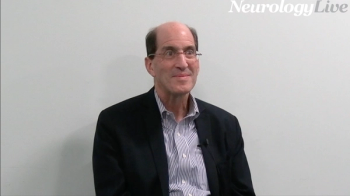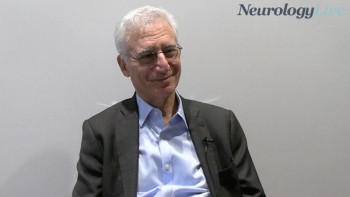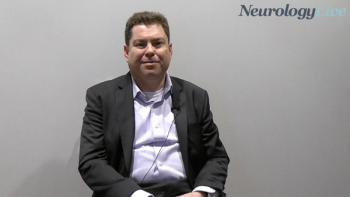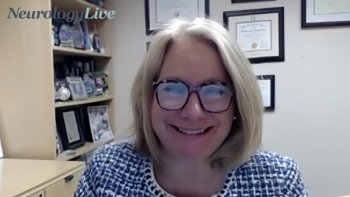
New data from the phase 3 SKYLINE study suggests soticlestat as a promising adjunctive therapy for seizures among children and young adults living with Dravet syndrome.

New data from the phase 3 SKYLINE study suggests soticlestat as a promising adjunctive therapy for seizures among children and young adults living with Dravet syndrome.

The chief medical officer at Stoke Therapeutics provided commentary on the promising mechanism of action of STK-001, an antisense agent, in the treatment of Dravet syndrome. [WATCH TIME: 3 minutes]

Krista L. Lanctôt, PhD, professor of psychiatry and pharmacology at the University of Toronto, talked about findings from a recent post hoc analysis presented at CTAD 2024 on nabilone for agitation in Alzheimer disease.

Factors like education level, hypertension, diabetes, and depression did not significantly predict epilepsy risk in patients with dementia.

Brad Chapman, head of U.S Epilepsy and Rare Syndromes at UCB, provided context on some of the innovative research and studies being presented at the 2024 American Epilepsy Society Annual Meeting.

In both the randomized controlled trial and open-label extension, a higher proportion of patients without VNS achieved at least 50% and 75% seizure reductions compared to those with concomitant VNS treatment.

The Le Bonheur Chair in Pediatric Neurology at the University of Tennessee Health Science Center highlighted the benefits and challenges of using stiripentol, an FDA-approved treatment for Dravet syndrome. [WATCH TIME: 4 minutes]

Fenfluramine showed a consistent safety profile in treating Lennox-Gastaut syndrome, with common adverse events such as decreased appetite, fatigue, and somnolence.

The epileptologist at UCLA Health provided perspective on a poster presented at AES 2024 that characterized a specific subgroup of patients with developmental epileptic encephalopathy and their response to certain therapies. [WATCH TIME: 3 minutes]

A recent study presented at AES 2024 revealed that plasma p-tau217 linked to memory decline and sleep disruptions in late-onset epilepsy, highlighting its potential as a biomarker.

Although the study was limited, the data warrant further research and a raised awareness of the elevated risk associated with sleep apnea comorbidities in younger patients with epilepsy.

Participants in the intervention group also reported themes of increased connectivity, creativity, and positivity.

Treatment with relutrigine resulted in a 46% placebo-adjusted reduction in motor seizures, along with a well-tolerated safety profile with adverse events that were mild to moderate.

The director of epilepsy surgery at Allegheny Health Network talked about research recently presented at AES 2024 on stereo-electroencephalography, a minimally invasive treatment for patients with epilepsy. [WATCH TIME: 7 minutes]

Treatment with bexicaserin, a highly selective 5-HT2c receptor superagonist, resulted in reduction in countable motor seizures in patients not previously exposed to the agent.

In a further date from the ongoing open-label extension of the phase 2b X-TOLE study, results demonstrated that the majority of treatment-emergent adverse events associated with azetukalner were mild or moderate.

A recent study presented at AES 2024 showed that fewer than 15% of doses of diazepam nasal spray administered to pediatric patients with epilepsy required a second dose in 24 hours.

CBD maintained a favorable safety profile, with 63% of participants experiencing adverse events such as diarrhea, vomiting, decreased appetite, and lethargy, leading to discontinuation in four patients.

Rachana K. Gandhi Mehta, MBBS, an assistant professor of neurology at Wake Forest School of Medicine, discussed a new, innovative trial assessing the therapeutic potential of self-administered subcutaneous rozanolixizumab as a treatment for myasthenia gravis.

Findings from a phase 2/3 study demonstrated the efficacy and safety of a higher dose regimen of nusinersen in treating spinal muscular atrophy in both treatment-naïve and previously treated patients.

These results highlight the age range and ambulation status for which viltolarsen is a key treatment option for DMD patients amenable to exon 53 skipping.

The vice president of scientific engagement at the Alzheimer's Association discussed advancements in blood biomarker tests, their use in specialty care, and the development of clinical guidelines for broader integration.

The cofounder and chief science officer of the Alzheimer's Drug Discovery Foundation highlighted the critical role of collaboration and innovative diagnostics for advancing Alzheimer disease care. [WATCH TIME: 4 minutes]

The study, presented at the 2024 AANEM) Annual Meeting, evaluated 52 patients who underwent surgery for carpal tunnel syndrome and explored the comparative effectiveness of the Conway and Zeidman scales in predicting patient outcomes.

Jessica Langbaum, PhD, the senior director of research strategy at Banner Alzheimer’s Institute, discussed the challenges and opportunities in improving diversity in Alzheimer disease clinical trials.

The multicenter, 24-week study will feature 20 patients with MG, testing changes on MG-ADL as well as several other secondary outcomes, including patient-reported assessments.

Overall, subcutaneous efgartigimod was safe and effective in patients with seropositive MG, demonstrated by consistent improvements in Myasthenia Gravis-Activites of Daily Living.

The professor of neurology and radiology at University of California, San Francisco, discussed the potential of blood-based biomarkers in Alzheimer treatment eligibility, highlighting current limitations and the importance of safety monitoring. [WATCH TIME: 7 minutes]

The neurologist in the Headache Center at Cleveland Clinic shared her post perspective on the 2024 AHS Scottsdale meeting which highlighted advancements in headache medicine and the growing impact of the field on patient care. [WATCH TIME: 5 minutes]

The trial, a 20-week study assessing lamotrigine in DLB, will use change in Clinical Dementia Rating-Sum of Boxes as the primary efficacy end point, with several other notable secondary outcomes.